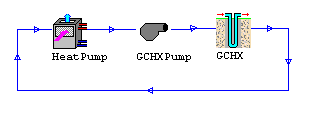



![]()
The ground loop operates in the following manner. When heating or cooling is required of the heat pump, the ground loop pump will move fluid from the ground heat exchangers to the heat pump. The heat pump will then add/remove heat from the fluid and return the fluid to the ground loop where this heat must be rejected to/absorbed from the earth.
The key components in any ground source heat pump application are the ground heat exchangers. In this simulation, two U-tube ground heat exchangers are used to reject/absorb heat to/from the ground. U-tube ground heat exchangers are relatively simple devices. The heat exchanger consists of a long piece of pipe formed into a "U" shape. This U-tube is then inserted into a deep hole drilled into the earth called a borehole. After the U-tube has been placed in the earth, the borehole is backfilled with soil or a thermal-enhanced grout.The two ground heat exchangers are hooked up in parallel and are typically buried about 15 feet apart.
![]()
The ground heat exchanger design is critical in these systems. If the ground heat exchangers are too short, the temperature of the fluid returning to the heat pump is too hot (cooling) or too cold (heating); causing performance degradation and possible equipment failure.
In this simulation, the thermal and hydraulic effects of the horizontal pipes leading to and from the ground heat exchangers are ignored since they typically account for only a small fraction of the overall heat transfer.
The ground heat exchangers are modeled with a very detailed model written at the University of Lund, Sweden. This model accounts for the thermal properties of the fluid, pipes, backfill, and soil and is considered the finest ground heat exchanger model in the world today. This model has been incorporated into TRNSYS to take advantage of the many TRNSYS benefits derived from modular simulation.
![]()